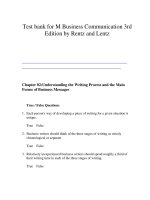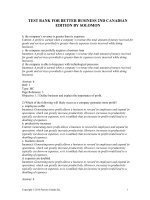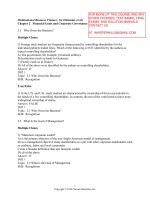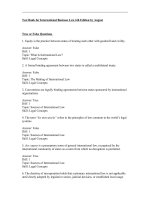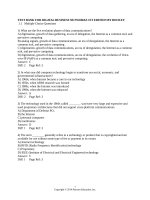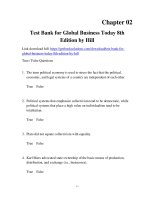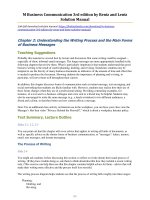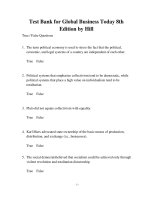test bank for m business communication 3rd edition by rentz and lentz 180321031124
Bạn đang xem bản rút gọn của tài liệu. Xem và tải ngay bản đầy đủ của tài liệu tại đây (497.43 KB, 102 trang )
Test bank for M Business Communication 3rd
Edition by Rentz and Lentz
Chapter 02:Understanding the Writing Process and the Main
Forms of Business Messages
True / False Questions
1. Each person's way of developing a piece of writing for a given situation is
unique.
True False
2. Business writers should think of the three stages of writing as strictly
chronological or separate.
True False
3. Relatively inexperienced business writers should spend roughly a third of
their writing time in each of the three stages of writing.
True False
4. Information is gathered and analyzed during the planning stage of the
writing process.
True False
5. While it is necessary to plan your message keeping your audience in mind,
concentrating on the audience's interests in later stages will impede the
writing process.
True False
6. If you have information that your readers will consider routine, neutral, or
positive, present such information at the end of your message.
True False
7. Trying to make your first draft a perfect draft can make you forget important
information and slow down the writing process.
True False
8. Proofreading for mechanical and grammatical elements is the final step in
the revision process.
True False
9. Memos are primarily used for corresponding with people outside an
organization.
True False
10.The memos' function of communicating within a business has been largely
replaced by email.
True False
11.Memorandums tend to use casual or informal language.
True False
12.The high-costs associated with using email are the reason why most
businesses do not use it for communicating with their internal audiences.
True False
13.The "Bcc" field in an email message stands for "backup confidential copy."
True False
14.Using initialisms, such as "BTW" and "ASAP," is acceptable in casual
business emails.
True False
15.You should avoid the use of informal language in business email messages,
especially when writing to people you know only on a business basis.
True False
16.Businesses use text messaging primarily for data reporting purposes.
True False
17.It is best to avoid the use of abbreviations when composing text messages.
True False
18.Employers are just as likely to reject a candidate as they are to hire a
candidate based on what is on someone's social networking site.
True False
19.On the job, companies often monitor employees' computer activity to detect
inappropriate or unethical behavior or disclosure of proprietary information.
True False
20.According to the inverted pyramid style of organizing Web pages, historical
or background information concerning the point at hand should be presented
first.
True False
Multiple Choice Questions
21.Which of the following is true of written communication?
A. The punctuation used in written communication is characteristic of the
object or concept that it represents.
B. The alphabets used in written communication are characteristic of the
object or concept that they represent.
C. Representing something in words is relatively easier than representing it
with a photograph.
D. In written communication, writers cannot rely on their tone of voice to
make up for ambiguous wording.
E. Writing is, in every way, less difficult to do well than other kinds of
communication.
22.Which of the following is true about the process of writing?
A. The stages involved in the writing process are strictly chronological.
B. Preparing to write and improving what you have written are not as critical
to success as the drafting stage.
C. Writers should spend most of their time on drafting and little time on the
other two stages, planning and revising.
D. The stages involved in the process of writing are independent of one
another.
E. The three stages involved in the process of writing are recursive and
interrelated.
23.Which of the following is true about the different stages involved in the
writing process?
A. Business writers should think of the three stages as strictly chronological
or separate.
B. The stages involved in the writing process are not recursive.
C. Novice business writers should spend roughly a third of their writing time
in each of the three stages.
D. The revising stage of the writing process becomes redundant when a
message is well drafted.
E. Skipping the planning stage saves time and makes the writing process
more efficient.
24.Which of the following is true regarding the amount of time novice business
writers should ideally spend on each stage of the writing process?
A. They should spend an equal amount of time on each of the three stages.
B. They should spend an equal amount of time on drafting and planning and
skip revising.
C. They should spend most of their time on drafting and revising and skip
planning.
D. They should spend most of their time on planning and less time on
drafting and revising.
E. They should spend most of their time on revising and less time on
planning and drafting.
25.The first step in the process of writing is _____.
A. planning
B. drafting
C. editing
D. revising
E. proofreading
26.Regarding the writing process, which of the following steps is typically
included as part of the planning process?
A. Revising your content
B. Determining your goals
C. Editing your language
D. Proofreading your documents
E. Getting feedback from others
27.Which of the following statements is true about the planning stage of the
writing process?
A. The planning stage is the last stage in the writing process.
B. A business writer should spend more time on drafting and skip the
planning stage.
C. The planning stage is independent of the drafting stage.
D. This stage involves the convergence of a writer's business goals with his
writing goals.
E. A business writer should spend more time on planning and skip revising.
28.As director of the human resources department, Alex has to write an email to
the employees requesting them to volunteer at the company's annual United
Way fund raiser. After determining the purpose of his message, which of the
following steps should Alex take next in planning his message?
A. Alex should analyze and organize the information.
B. Alex should analyze his audience.
C. Alex should choose an appropriate channel.
D. Alex should gather information.
E. Alex should choose a document format.
29.In the context of planning a message, once the goal of a communication is
set, the immediate next step is to _____.
A. choose a format for writing the message
B. proofread the message
C. choose a channel for communicating the message
D. gather and collect information
E. analyze the audience
30.Which of the following constitutes formal research in the context of
gathering information for a message?
A. Finding past correspondence
B. Conducting a survey
C. Reviewing sales records
D. Consulting with employees
E. Reviewing product descriptions
31.When using the direct order plan to organize your information in a message,
you should _____.
A. present information that readers consider routine in the beginning
B. present information that readers consider positive at the end
C. present information that readers consider neutral at the end
D. avoid beginning your message by stating your objective
E. avoid delivering good news at the beginning of the message
32.Which of the following is the best practice to be followed when writing
messages?
A. Organizing information in the order that will draw the most positive
reaction from your readers
B. Gathering information through formal research rather than relying on
memory or imagination
C. Analyzing your audience early in the planning process before determining
the goal of your message
D. Presenting information that you think could run the risk of evoking a
negative response at the beginning of your message
E. Ensuring that your business goals and writing goals are disparate and do
not influence each other
33.In which of the following cases will the direct order plan of organizing
information be most effective?
A. In a letter to the parents of a student regarding his poor academic
performance
B. In an email to an employee informing him about his dismissal
C. In an email to a client who has requested the shipping details for a
purchased product
D. In an email to a supplier informing the party about the organization's plan
of switching to a different supplier
E. In a letter to a customer apologizing for the delay in delivering a shipment
34.The direct order plan of organizing information will be the most effective in
writing _____.
A. an email to employees announcing mandatory evening and weekend
overtime
B. an email to a pharmaceutical company informing it of the termination of
its license
C. a memo to an employee informing him of his dismissal from the company
D. an email to the HR manager asking her how to access the new forms for
reporting vacation time
E. a letter to a client apologizing for a late payment
35.The indirect order plan of organizing information in a message is best suited
for messages containing information that _____.
A. is likely to evoke a negative response from your readers
B. your readers will consider neutral data
C. your readers will consider routine data
D. is likely to evoke a positive response from your readers
E. is likely to evoke curiosity in your readers
36.In which of the following cases will the indirect order plan of organizing
information be most effective?
A. In an automated email response to emails sent to a work email ID
B. In a letter to a government official requesting the renewal of one's work
permit
C. In an email to a supplier asking for a fresh supply of raw materials
D. In an email to a supplier about the organization's plan of switching to a
different supplier
E. In an email containing the weekly newsletter which describes the
activities of the organization
37.William wants to communicate information to a client, but he thinks that the
information runs the risk of evoking a negative response. In this context,
which of the following formats should William use to organize the
information in his message?
A. Chronological order
B. Direct order
C. Critical order
D. Indirect order
E. Complex order
38.Which of the following should ideally be avoided during the drafting stage
of the writing process?
A. Creating a flexible draft that can be changed over time
B. Focusing on creating a perfect draft on the first attempt
C. Focusing on the primary purpose of the message
D. Moving forward at a reasonably steady pace with as little stalling as
possible
E. Working on a draft when productivity is the highest
39.You examine your sentences to see if they pace the information in such a
way that the reader can easily follow it, if they emphasize the right things,
and if they combine pieces of information coherently at the _____ level of
the revision process.
A. editing
B. proofreading
C. channel selecting
D. form selecting
E. revising
40.Michael is in the process of writing a message. He is trying to find out
whether the words he has used to describe his goals emphasize the right
things and if there are better, more concise ways of structuring his sentences.
In the context of the different stages involved in writing, Michael is _____
his message.
A. formatting
B. scanning
C. revising
D. planning
E. drafting
41.In the proofreading stage of the writing process, you are most likely to
_____.
A. examine your sentences to see if they emphasize the right things
B. choose the right channel for transmission
C. analyze your audience
D. select an appropriate medium for delivering your message
E. check the mechanical and grammatical elements of your message
42.Which of the following is true about the revision stage of the writing
process?
A. At this stage, a writer checks whether he has included all the necessary
information in his message.
B. This stage is independent of the other two stages in the writing process.
C. This stage is not necessary, and can be omitted, when the message is well
drafted.
D. All preliminary decisions regarding the document's format or visual
design are made at this stage.
E. At this stage, the writer must choose an appropriate form of
communication for his message.
43._____ are the oldest form of business messages.
A. Letters
B. Blogs
C. Emails
D. Telegraphs
E. Text messages
44.A(n) _____ is primarily used to represent the writer and his or her topic
rather formally to an external audience.
A. memorandum
B. instant message
C. short message service
D. text message
E. letter
45.Which of the following statements is true about the use of letters?
A. Letters are primarily used to communicate information that is not routine
or neutral.
B. Letters that are formal are required to include the attention line and
subject line.
C. Letters are often the most appropriate form to use when corresponding
with an external party whom you do not know well.
D. Letters have become less conversational over time and have replaced
other forms of communications like email and memos.
E. Letters are used primarily for corresponding with people inside your
organization.
46.Which of the following is a commonly used complimentary close in today's
business letters?
A. To Whom It May Concern
B. Best Regards
C. Dear Sir/Madame
D. Respected Sir
E. Sincerely Yours
47.Jason Smith is writing a letter to one of his prospective clients, Alex Harper,
the sales manager at Perry McKay Fashion House. Having sourced Alex's
contact details from a vendor, Jason is unsure of Alex's gender. How should
he address Alex in his letter?
A. Dear Perry McKay Fashion House
B. To Whom It May Concern
C. Dear Sir/Madame
D. Dear Alex Harper
E. Dear
48.Which of the following is true about memos or memorandums?
A. Memos, at present, are used instead of emails as a means of
communicating within a business.
B. Memos are primarily used to communicate with external audiences.
C. Memos have the same form as other messages.
D. Memos generally use casual or informal language.
E. Memos are especially useful for communicating with employees who use
computers in their work.
49.Memorandums can be distinguished from other messages primarily by their
_____.
A. purpose
B. style
C. language
D. users
E. form
50.In today's business world, _____ are the most widely used form of written
communication.
A. text messages
B. instant messages
C. letters
D. memos
E. emails
51.Which of the following statements is true about emails?
A. There is a limitation on the number of characters a writer can use in an
email.
B. Because of their low speeds and high costs, emails have been replaced by
memorandums.
C. Emails can be archived and filed for easy access to a written record of
correspondence.
D. Emails cannot be easily forwarded and hence offer a great deal of
confidentiality.
E. Emails are the least widely used means of written communication at
workplace.
52.With respect to the email format, Cc stands for _____.
A. customer copy
B. check correction
C. company copy
D. client conformation
E. courtesy copy
53.Which of the following is an advantage of email over text messaging, instant
messaging, and social media?
A. Email provides the option of using images.
B. Email can be sent to internal and external audiences.
C. Email is relatively faster than the other modes of communication.
D. Email is less expensive to use than the other modes of communication.
E. Email does not limit the number of characters that can be used in a
message.
54.With respect to email format, the link "Bcc" or "blind courtesy copy" is used
when _____.
A. the sender wants to stress that one or more of the recipients are not
primary contact persons
B. the sender wants the recipient to forward the email to a specific set of
people
C. the sender wants to forward copies of the email without the knowledge of
the primary receiver
D. the sender wants the recipients of the email to get in touch with each
other
E. the sender wants to attach files to the email for the primary receiver to
download
55.If someone other than the primary recipient is to receive a copy of the
message in such a way that the primary recipient will know who else has
received a copy of the message, the sender should use the _____ field.
A. To
B. Cc
C. Subject
D. Attachment
E. Bcc
56.When communicating with close friends, the email messages that are
exchanged every day _____.
A. use a casual style of writing
B. do not make use of colloquialisms
C. use sentences that are well structured and organized
D. avoid personal references and contractions
E. refrain from using mechanical emphasis devices and initialisms
57.Which of the following statements is true about informal writing?
A. It does not share any of the characteristics of casual writing.
B. It uses colloquialisms but more selectively than in casual writing.
C. It makes use of long, complex sentences to get the point across.
D. It has the effect of conversation and sounds like chitchat.
E. It entirely avoids the use of personal pronouns and contractions.
58.The similarity between casual language and informal language is that
_____.
A. they do not use personal pronouns
B. they have the effect of conversation
C. they do not use colloquialisms
D. they are primarily used to communicate with unknown external audiences
E. they avoid using contractions
59.In the context of writing email messages, a formal style of writing _____.
A. maintains a shorter distance between writer and reader than an informal
style
B. makes extensive use of personal references and contractions
C. uses sentences that are well structured and highly organized
D. uses sentences that are short, unstructured, and incomplete
E. uses mechanical emphasis devices and initialisms
60.Which of the following writing styles should be used in an email report to
the client of a research organization?
A. Casual style
B. Informal style
C. Formal style
D. Conversational style
E. Flaming style
61.In which of the following messages would it be appropriate to use informal
language?
A. A message from an HR manager to his company's CEO, requesting an
appointment
B. A message written by a customer care executive to a new customer,
welcoming her
C. A message written to a coworker, asking her about her plans for the day
D. A letter written to a government official, requesting for the renewal of
one's work permit
E. A message written by a line manager to the CIO of the company
62.Which of the following forms of communication places a strong emphasis
on brevity?
A. Emails
B. Text messages
C. Letters
D. Memos
E. White papers
63.While typing a text message, Mike uses the emoticon ":-0". This emoticon
indicates that Mike is _____.
A. laughing
B. frowning
C. winking
D. Smiling
E. yelling
